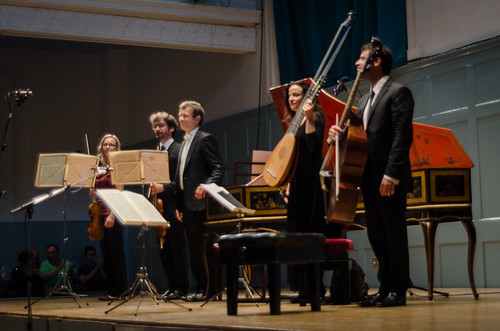by Guest Blogger: Mandy Macdonald
One of the greatest treats for me – and for all Baroque music lovers – at this year’s Edinburgh Festival was the three memorable performances by French harpsichord virtuoso Christophe Rousset on no fewer than six of the instruments in Edinburgh University’s Raymond Russell Collection. There were two solo recitals in St Cecilia’s Hall, the home of the Collection and Edinburgh’s oldest (and most elegant) purpose-built concert hall, and a morning concert with members of his band Les Talens Lyriques in the Queen’s Hall.
Please subscribe to this blog – in the top right corner – and receive notifications of new posts by email.
Rousset is as much at ease with delicate, reflective works where emotional intensity springs from rubato and inégalité as with flashy, rattling display pieces. In each case, the music chosen and the style of playing were sensitive to the demands and possibilities of the instrument. So sensitive, in fact, that the instruments themselves, brought gloriously into voice by Rousset’s playing, threatened to steal the show.
The Russell Collection is the core of the university’s large collection of early keyboard instruments. It was gifted to the university after Raymond Russell’s death in 1964. St Cecilia’s Hall, dating from 1763, is Scotland’s first purpose-built concert hall. A link to the catalogue of all the instruments in the collections is here.
St Cecilia’s Hall and the Russell Collection are intimately linked, and the instruments rarely leave their home, so it was particularly exciting to see the exquisite Goermans/Taskin harpsichord on the stage of the Queen’s Hall with Rousset and Les Talens Lyriques. This instrument (see the soundboard painting here), originally built in 1764 by Jean or Jacques Goermans, French harpsichord-makers of Flemish origin, was much altered in 1783 by Pascal Taskin, the foremost Paris maker at the time. Rousset himself singles it out as “the jewel of the collection”. See the whole instrument here.
Christophe Rousset talks here (on video) about playing the Russell Collection’s harpsichords
More beautiful even than the famous Taskin harpsichord of 1769, probably the most widely reproduced harpsichord in the world?
Well, Rousset doesn’t specifically say so in the interview above, but the 1769 instrument featured in his second solo recital in works by Rameau and Claude-Bénigne Balbastre (1727–99) and hectic encores by Pancrace Royer, music teacher to the daughters of Louis XV.
The Goermans/Taskin, though, was the perfect vehicle for the refined, deceptively simple textures of François Couperin’s seventh Ordre, especially the velvety lower register Couperin uses to heart-wrenching effect. I was ready to agree with John Kitchen’s programme note:
The textures, ornamentation and many other subtle aspects of French harpsichord music, and arguably of Couperin’s in particular, are inextricably bound up in the sound and touch of contemporary French harpsichords. The music cannot be played convincingly on any other instrument – not even on 18th-century harpsichords from other traditions.
A musical “cake shop”
Other instruments being tasted in this musical “cake shop”, as Rousset calls the Collection, were:
- an Italian virginals of 1586 by Alexander Bertolotti, surviving in almost original condition and playability; used for a group of pieces by Girolamo Frescobaldi (1583–1643);
- an anonymous Italian harpsichord of 1620 or thereabouts, originally with an enharmonic keyboard – splitting the G sharp and E flat keys in the middle octave – but subsequently updated by Bartolomeo Cristofori (inventor of the piano) or one of is pupils; used for four lesser-known Scarlatti sonatas (K34, 450, 308, and 309);
- a 1755 harpsichord by Luigi Baillon, who may have been born in Italy but who seems to have incorporated both French and Saxon features into his instrument; used for a spectacular sonata (H32) by C. P. E. Bach;
- an English harpsichord (1709) by Thomas Barton which also combines Italian and English styles; on this one the elfin Rousset gave us works by J. J. Froberger (1616–67), Louis Couperin (c. 1626–1661), and Henry Purcell.
While the differences in sound and timbre between the plangency of the early instruments and the fuller sound of the 18th-century harpsichords were clear, those between the several 18th-century machines were subtler, but still detectable.
For instance, John Kitchen notes a contrast between the luscious fullness of the Taskin and the less rounded tone of the Baillon harpsichord used for the Bachs (J. S. and C. P. E.): the latter, with a reedier tone than the typical Parisian instrument of the time, would have sounded more familiar to Bach, and was perfect for the F sharp minor Prelude and Fugue from Das wohltemperirte Clavier II, where its less rounded tone let the fugal structure speak out.
It was truly wonderful to have the opportunity to hear all these important instruments in excellent playing order. The pleasure was only increased by Rousset’s introductory remarks as he moved smoothly from one instrument to another, giving both him and the audience a moment to “change gear” into a different playing style and listening mode.
The series of performances, and the restoration of the instruments to good playing order, were generously supported by Dr George & Mrs Joy Sypert, who are to be heartily thanked for choosing the Collection as the focus of their benefaction and enabling so many of these “wondrous machines” to be played to such a virtuosic standard.
I, for one, hope that these important instruments can be seen more often beyond St Cecilia’s Hall, and that perhaps recordings of Rousset playing them will be forthcoming to re-cement the Auld Alliance between Scotland and France!
Listen now:
A programme of music by Purcell, Couperin, Rameau, and Froberger from one of these concerts, recorded for the Early Music Show by the BBC.
© Mandy Macdonald 2013


Leave a Reply